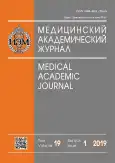The effect of chronic emotional and physical stress on the neuroendocrine and immune systems
- Authors: Yankelevich I.A.1,2, Filatenkova T.A.1,2, Shustov M.V.2
-
Affiliations:
- Institute of Experimental Medicine
- Saint Petersburg State Chemical Pharmaceutical University
- Issue: Vol 19, No 1 (2019)
- Pages: 85-90
- Section: Original research
- Published: 02.07.2019
- URL: https://journals.eco-vector.com/MAJ/article/view/15194
- DOI: https://doi.org/10.17816/MAJ19185-90
- ID: 15194
Cite item
Abstract
The aim of the presented study was to characterize the developed model of chronic stress. Most of the currently existing models of chronic stress are long, laborious, hard to employ, and also difficult to reproduce, which leads to restrictions in their use. Daily swimming in cold water for 10 days model was proposed as a model of chronic stress. The described influence led to a significant involution of the thymus, an increase in the expression of the interleukin-4 (IL-4) and interleukin-6 (IL-6) genes in the thymus, and its decrease in the hypothalamus, a change in behavioral reactions, as well as a multiple increase in the blood concentration of corticosterone in the experimental animals. The data suggest that repeated swimming in cold water in experimental animals causes changes in the activity of the hypothalamic-pituitary-adrenal system, the immune system, and also demonstrate the possibility of using the presented model as a model of chronic stress.
Full Text
About the authors
Irina A. Yankelevich
Institute of Experimental Medicine; Saint Petersburg State Chemical Pharmaceutical University
Author for correspondence.
Email: rina.yankelevich@pharminnotech.com
SPIN-code: 9249-6844
PhD in Biological Sciences, Senior Research Fellow, Assistant Professor
Russian Federation, Saint PetersburgTatyana A. Filatenkova
Institute of Experimental Medicine; Saint Petersburg State Chemical Pharmaceutical University
Email: lero269@gmail.com
SPIN-code: 4198-3636
Research Fellow
Russian Federation, Saint PetersburgMark V. Shustov
Saint Petersburg State Chemical Pharmaceutical University
Email: shustovmark99@gmail.com
Student
Russian Federation, Saint PetersburgReferences
- Everly GS, Lating JM. A clinical guide to the treatment of the human stress response. New York: Springer; 2013. 456 p. https://doi.org/10.1007/978-1-4614-5538-7.
- Newton TL, Fernandez-Botran R, Lyle KB, et al. Salivary cytokine response in the aftermath of stress: An emotion regulation perspective. Emotion. 2017;17(6):1007-1020. https://doi.org/10.1037/emo0000156.
- Black PH. Central nervous system-immune system interactions: psychoneuroendocrinology of stress and its immune consequences. Antimicrob Agents Chemother. 1994;38(1):1-6. https://doi.org/10.1128/aac.38.1.1.
- Padgett DA, Glaser R. How stress influences the immune response. Trends Immunol. 2003;24(8):444-448. https://doi.org/10.1016/s1471-4906(03)00173-x.
- Tracey KJ. The inflammatory reflex. Nature. 2002;420(6917):853-859. https://doi.org/10.1038/nature01321.
- Kadmiel M, Cidlowski JA. Glucocorticoid receptor signaling in health and disease. Trends Pharmacol Sci. 2013;34(9):518-530. https://doi.org/10.1016/j.tips.2013.07.003.
- Webster JI, Tonelli L, Sternberg EM. Neuroendocrine regulation of immunity. Annu Rev Immunol. 2002;20:125-163. https://doi.org/10.1146/annurev.immunol.20.082401.104914.
- Haarman BC, Riemersma-Van der Lek RF, de Groot JC, et al. Neuroinflammation in bipolar disorder — A [(11)C]-(R)-PK11195 positron emission tomography study. Brain Behav Immun. 2014;40:219-225. https://doi.org/10.1016/j.bbi.2014.03.016.
- Солодков А.П., Яцковская Н.М. Стресс, адаптация и цитокины // Фундаментальные и прикладные проблемы стресса: Материалы международной научно-практической конференции; Витебск, 10 июня 2010 г. – Витебск, 2010. – С. 13–19. [Solodkov AP, Yatskovskaya NM. Stress, adaptatsiya i tsitokiny. In: Proceedings of the International Scientific and Practical Conference “Fundamental’nye i prikladnye problemy stressa”; Vitebsk; 10 Jun 2010. Vitebsk; 2010. P. 13-19. (In Russ.)]
- Abelson JL, Khan S, Liberzon I, Young EA. HPA axis activity in patients with panic disorder: review and synthesis of four studies. Depress Anxiety. 2007;24(1):66-76. https://doi.org/10.1002/da.20220.
- Старская И.С., Полевщиков А.В. Морфологические аспекты атрофии тимуса при стрессе // Иммунология. – 2013. – Т. 34. – № 5. – С. 271–277. [Starskaya IS, Polevshchikov AV. Morphological aspects of atrophy of the thymus under stress. Immunologiia. 2013;34(5):271-277. (In Russ.)]
- Vitkovic L, Bockaert J, Jacque C. “Inflammatory” Cytokines. J Neurochem. 2001;74(2):457-471. https://doi.org/10.1046/j.1471-4159.2000.740457.x.
Supplementary files











